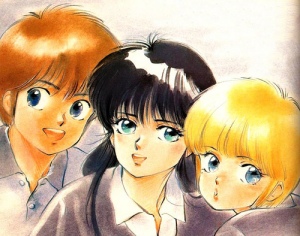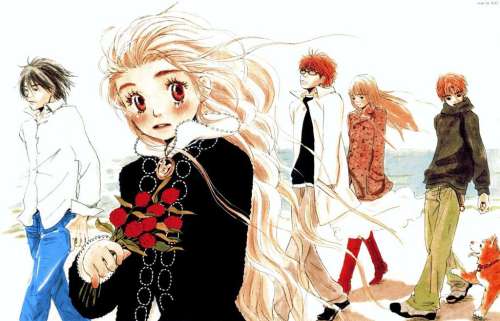In the spirit of Valentine’s Day, I thought I’d write about some of the best and most unique love triangles in anime and manga. There are many many love polygons to be found throughout anime and manga, even in series that don’t specifically focus on romance. And while this may be a shojo blog, some of my personal favorite love triangles are from shonen and seinen series, so this list won’t be limited to just shojo examples. I hope you guys enjoy!
 ♥Kyosuke-Madoka-Hikaru (Kimagure Orange Road)♥
♥Kyosuke-Madoka-Hikaru (Kimagure Orange Road)♥
Why it stands out: They’re all best friends.
In my opinion, Kimagure Orange Road is the quintessential shonen-romantic comedy series and features one of the best love triangles in anime and manga. At first glance, this triangle may seem straightforward: Kyosuke is a newcomer to town and is torn between a sweet, clingy girl named Hikaru and the ‘bad girl’ Madoka whom he falls in love with at first sight. However, this series raises the stakes because not only are Hikaru and Madoka best friends, but as the series progresses the trio become close friends, making Kyosuke’s inevitable rejection of Hikaru in the series’ first film all the more painful.
♥Kyoko-Godai-Mitaka (Maison Ikkoku)♥
Why it stands out: They’re all sympathetic.
One of the best romantic-comedies there is, this classic 80s seinen series features a love triangle between Kyoko, a widow who becomes the mangager of a run-down boarding house, Godai, a poor college student who is Kyoko’s tenant, and Mitaka, a coach at Kyoko’s tennis school. This is one of the few love triangles I’ve encountered where I liked and sympathized with everyone involved: it’s easy to understand why Kyoko is so reluctant to pursue either of her suitors as she struggles to overcome her husband’s death, and I love that both Godai and Mitaka are very respectful of Kyoko’s feelings. You can’t help but root for Godai to win Kyoko’s heart not only because he is the complete underdog, but because he matures into such a sweet and caring guy. And while in most series the charming rich love interest usually comes across as a jerk, when Kyoko finally rejects Mitaka after he has waited for her to reciprocate his feelings for almost four years, I couldn’t help but cry.
 ♥Tsukushi-Tsukasa-Rui (Boys Over Flowers/Hana Yori Dango)♥
♥Tsukushi-Tsukasa-Rui (Boys Over Flowers/Hana Yori Dango)♥
Why it stands out: It’s unpredictable.
Even though I had been spoiled about who Tsukushi would choose before I got into the series, I still consider Boys Over Flowers’ main love triangle one of the least predictable love triangles in anime and manga. Soon after standing up to the rich clique of bullies at her school called the F4, Tsukushi develops feelings for Rui Hanazawa, the quietest member of the group. However, when the F4’s leader, Tsukasa Domyoji, begins to fall for Tsukushi, she finds herself torn between them. There is a lot of tension in this love triangle, particularly after Tsukasa confesses his feelings to Tsukushi in volume six and Tsukushi ends up feeling as though she betrayed Tsukasa by choosing Rui, and it was at this point in the series that I began to believe that I had been misinformed of who the main couple of the series was. However, Rui ends up rejecting her because he still has feelings for his first love, and over the course of the series Tsukushi finds herself slowly falling for Tsukasa, which made me elated. I think the main reason this love triangle feels so unpredictable is because the author originally intended for Tsukushi to end up with Rui but ended up changing the storyline when Tsukasa became more popular with the fans, allowing the shift in Tsukushi’s feelings to feel very genuine.
♥Akito-Sana-Fuka (Kodocha)♥
Why it stands out: They’re 12.
This was probably the first love triangle I ever became really invested in, which makes sense considering the fact that Kodocha is my favorite series. I love that Akito, who had been in love with Sana from early on in the series, starts dating Fuka when he believes Sana is interested in someone else, which serves as the catalyst for Sana to realize her feelings for him. This situation is exacerbated by the fact that Sana and Fuka are best friends, causing Sana to hide her feelings for Akito from both of them because she doesn’t want to hurt Fuka. None of them know how to handle the situation well because they are only twelve years-old. It doesn’t take long for Fuka to realize she’s the third wheel in this triangle, and I love the scene when Sana and Fuka finally confront one another. When Fuka admits that she doesn’t feel like Akito’s real girlfriend and Sana says she’ll take him from her, all I could think was ‘aww snap!,’ making this one of my favorite moments in anime love rivalry.
♥Sousuke-Kaname-Tessa (Full Metal Panic!)♥
Why it stands out: Sousuke only vaguely seems to realize he’s in a love triangle.
This is one of the few triangles where I enjoy the romantic moments of both possible pairings because while I prefer Kaname and Sousuke as a couple, I can’t help but like Tessa. While it’s fairly obvious that Sousuke is developing feelings for Kaname, the hot-tempered high school girl he’s supposed to be guarding, Sousuke is completely dense when it comes to love. This is especially true when it comes to his commanding officer Teletha ‘Tessa’ Testarossa, who is anything but shy about showing her feelings for him, which completely confuses (and possibly scares) the moody military officer. So while Sousuke may be completely oblivious to Tessa and Kaname’s feelings for him, the entanglements of this triangle are very fun to watch.
 ♥Momo-Kairi-Toji (Peach Girl)♥
♥Momo-Kairi-Toji (Peach Girl)♥
Why it stands out: She dates both of them.
In most shojo love triangles, when the main female character decides between her two leading love interests, she’ll generally stick with her choice and the losing guy will often find love with someone else. However, in Peach Girl, despite the fact that Momo starts going out with Toji, the guy she had a crush on prior to the beginning of the series, she not only later dates playboy Kairi Okayasu after Sae’s manipulations tear her and Toji apart, but she even ends up with Kairi. While there are a few other love triangles where the female dates both guys (such as in Sand Chronicles), it’s usually made obvious that she is only going out with the second guy as a rebound and is still in love with her first love interest. But in Peach Girl, despite the fact that Momo still has feelings for Toji when she starts dating Kairi, Kairi’s charms win Momo over and she eventually chooses him.
♥Hagu-Morita-Takemoto (Honey and Clover)♥
Why it stands out: (spoiler) She doesn’t end up with either of them.
While I’ve never personally cared for this love triangle because I never understood why either Morita or Takemoto was in love with the moody and introverted Hagu, it still stands out to me as a unique love triangle because she doesn’t choose either guy in the end. Even though Hagu is in love with Morita, Hagu decides to spend her time focusing on her artwork after her hand gets injured, and asks Shu (Professor Hanamoto) to stay by her side and help her. So even though I may not have been as invested in this love triangle, I respect Honey and Clover for not tying up all of the romantic loose ends like most series would, as well as for being one of the most poignant examples of unrequited love in anime and manga.
So what I’ve noticed is that I especially like love triangles where the people involved are friends. In these triangles, there is a lot more at stake, which is why they are so dramatic and interesting. If anyone has a love triangle they love or feel is unique, please feel free to comment!

